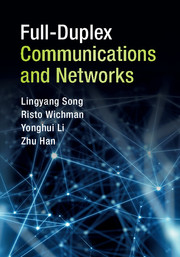Book contents
- Frontmatter
- Dedication
- Contents
- Preface
- 1 Basics of Communication Systems
- 2 Signal Processing and Theoretical Limits
- 3 Full-Duplex System Hardware Implementation
- 4 Full-Duplex MIMO Communications
- 5 Full-Duplex OFDMA Communications
- 6 Full-Duplex Heterogeneous Networks
- 7 Full-Duplex Cooperative Networks
- 8 Full-Duplex Cognitive Radio Networks
- 9 Full-Duplex Random Access Networks
- References
- Index
7 - Full-Duplex Cooperative Networks
Published online by Cambridge University Press: 16 March 2017
- Frontmatter
- Dedication
- Contents
- Preface
- 1 Basics of Communication Systems
- 2 Signal Processing and Theoretical Limits
- 3 Full-Duplex System Hardware Implementation
- 4 Full-Duplex MIMO Communications
- 5 Full-Duplex OFDMA Communications
- 6 Full-Duplex Heterogeneous Networks
- 7 Full-Duplex Cooperative Networks
- 8 Full-Duplex Cognitive Radio Networks
- 9 Full-Duplex Random Access Networks
- References
- Index
Summary
In this chapter, we introduce Full Duplex (FD) cooperative networks, consisting of one source node, multiple relays, and one destination. We assume that the relay works in a full duplex mode. Due to the residual self-interference in FD relay nodes, the analysis of FD relay systems will become essentially different from conventional relay systems. We will analyze the performance of FD Amplify-and-Forward (FA) relay systems. The performance of FD AF relay systems is limited by the residual self-interference. To overcome such a limitation, we will introduce an effective X-duplex relaying protocol, which switches adaptively between FD and Half-Duplex (HD) spatial multiplexing modes based on the channel conditions, such that the limitations of FD and HD can be overcome through such an adaptive protocol. Finally, we consider a general setup of multi-relay FD systems and introduce a joint antenna and relay selection scheme for such a network.
Cooperative Communication Basics
Before introducing FD relay networks, in this section, we first briefly introduce some basics of cooperative communications and relaying protocols.
The concept of cooperative communications can actually be traced back to the early work of Cover and ElGamal on achievable capacity of a relay network in 1979; it was rediscovered recently in relation to great potential applications in cellular and wireless sensor networks. The distributed nature of wireless networks provides a unique opportunity for cooperation and distributed signal processing. The design of efficient cooperative protocols and distributed signal processing techniques has been an important issue in implementing cooperative communications in wireless networks. Therefore, recent research on cooperative wireless networks has focused on designing relaying protocols, signaling and distributed coding. In particular, the design of efficient relaying protocols and distributed coding schemes has attracted significant attention and a number of novel relaying protocols and distributed coding schemes have been developed in the past several years. Capacity-approaching performance has been achieved by some elegantly designed distributed coding schemes.
When we talk about “cooperative networks” and “relay networks,” they have the following distinctions. In cooperative networks, each node acts as both a source and a relay node. That is, each node not only transmits its own information but also helps other nodes to transmit signals. In relay networks, the relay nodes are explicitly built nodes only for the purpose of relaying and forwarding information.
- Type
- Chapter
- Information
- Full-Duplex Communications and Networks , pp. 205 - 246Publisher: Cambridge University PressPrint publication year: 2017



